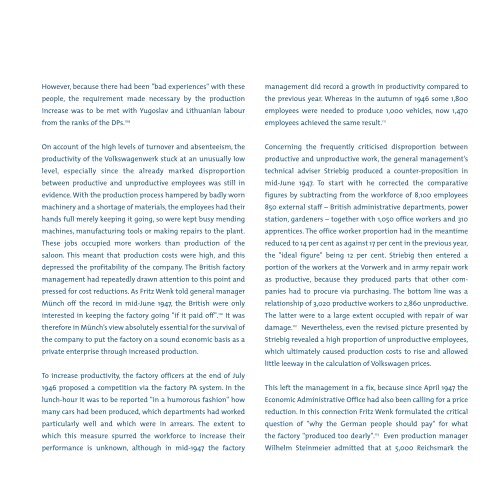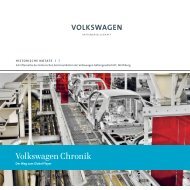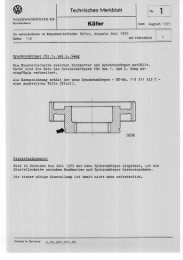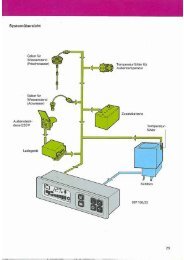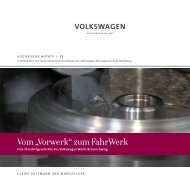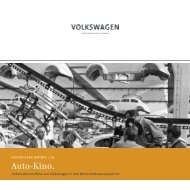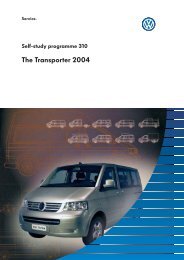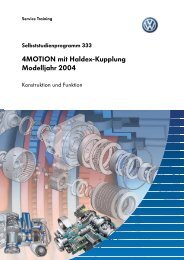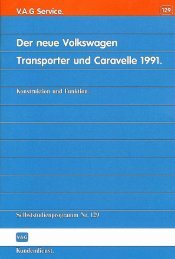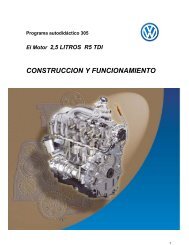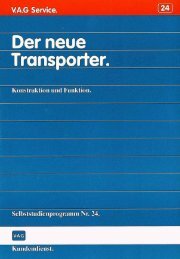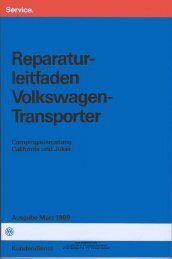HN 2: The British and their Works
HN 2: The British and their Works
HN 2: The British and their Works
You also want an ePaper? Increase the reach of your titles
YUMPU automatically turns print PDFs into web optimized ePapers that Google loves.
However, because there had been "bad experiences" with these<br />
people, the requirement made necessary by the production<br />
increase was to be met with Yugoslav <strong>and</strong> Lithuanian labour<br />
from the ranks of the DPs. 109<br />
On account of the high levels of turnover <strong>and</strong> absenteeism, the<br />
productivity of the Volkswagenwerk stuck at an unusually low<br />
level, especially since the already marked disproportion<br />
between productive <strong>and</strong> unproductive employees was still in<br />
evidence. With the production process hampered by badly worn<br />
machinery <strong>and</strong> a shortage of materials, the employees had <strong>their</strong><br />
h<strong>and</strong>s full merely keeping it going, so were kept busy mending<br />
machines, manufacturing tools or making repairs to the plant.<br />
<strong>The</strong>se jobs occupied more workers than production of the<br />
saloon. This meant that production costs were high, <strong>and</strong> this<br />
depressed the profitability of the company. <strong>The</strong> <strong>British</strong> factory<br />
management had repeatedly drawn attention to this point <strong>and</strong><br />
pressed for cost reductions. As Fritz Wenk told general manager<br />
Münch off the record in mid-June 1947, the <strong>British</strong> were only<br />
interested in keeping the factory going "if it paid off". 110 It was<br />
therefore in Münch’s view absolutely essential for the survival of<br />
the company to put the factory on a sound economic basis as a<br />
private enterprise through increased production.<br />
To increase productivity, the factory officers at the end of July<br />
1946 proposed a competition via the factory PA system. In the<br />
lunch-hour it was to be reported "in a humorous fashion" how<br />
many cars had been produced, which departments had worked<br />
particularly well <strong>and</strong> which were in arrears. <strong>The</strong> extent to<br />
which this measure spurred the workforce to increase <strong>their</strong><br />
performance is unknown, although in mid-1947 the factory<br />
management did record a growth in productivity compared to<br />
the previous year. Whereas in the autumn of 1946 some 1,800<br />
employees were needed to produce 1,000 vehicles, now 1,470<br />
employees achieved the same result. 111<br />
Concerning the frequently criticised disproportion between<br />
productive <strong>and</strong> unproductive work, the general management’s<br />
technical adviser Striebig produced a counter-proposition in<br />
mid-June 1947. To start with he corrected the comparative<br />
figures by subtracting from the workforce of 8,100 employees<br />
850 external staff – <strong>British</strong> administrative departments, power<br />
station, gardeners – together with 1,050 office workers <strong>and</strong> 310<br />
apprentices. <strong>The</strong> office worker proportion had in the meantime<br />
reduced to 14 per cent as against 17 per cent in the previous year,<br />
the "ideal figure" being 12 per cent. Striebig then entered a<br />
portion of the workers at the Vorwerk <strong>and</strong> in army repair work<br />
as productive, because they produced parts that other companies<br />
had to procure via purchasing. <strong>The</strong> bottom line was a<br />
relationship of 3,020 productive workers to 2,860 unproductive.<br />
<strong>The</strong> latter were to a large extent occupied with repair of war<br />
damage. 112 Nevertheless, even the revised picture presented by<br />
Striebig revealed a high proportion of unproductive employees,<br />
which ultimately caused production costs to rise <strong>and</strong> allowed<br />
little leeway in the calculation of Volkswagen prices.<br />
This left the management in a fix, because since April 1947 the<br />
Economic Administrative Office had also been calling for a price<br />
reduction. In this connection Fritz Wenk formulated the critical<br />
question of "why the German people should pay" for what<br />
the factory "produced too dearly". 113 Even production manager<br />
Wilhelm Steinmeier admitted that at 5,000 Reichsmark the


